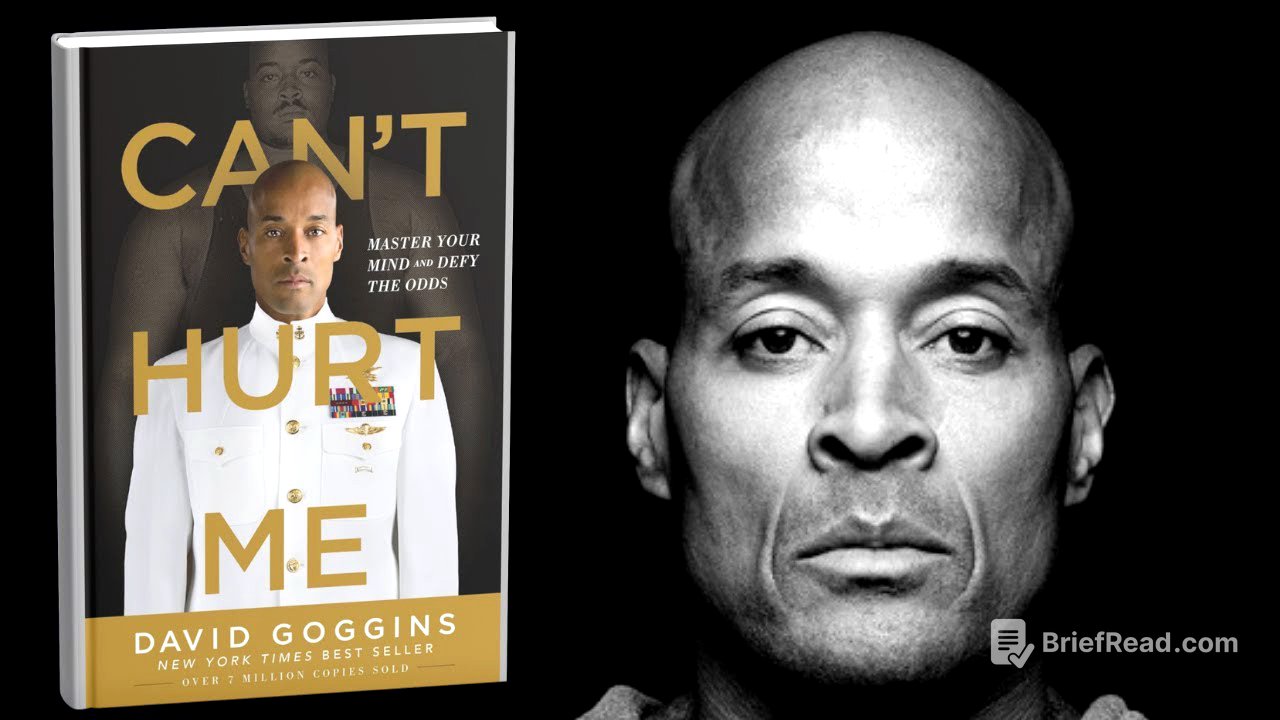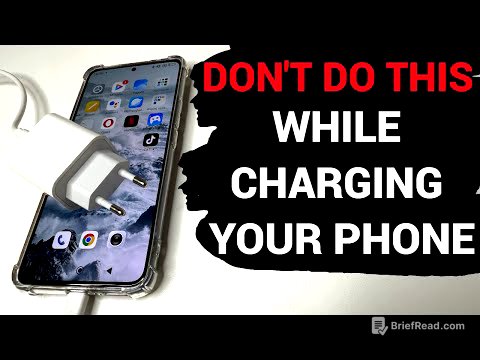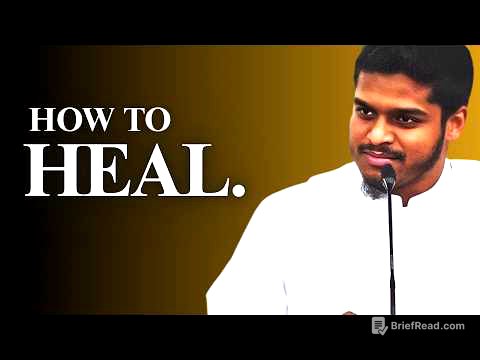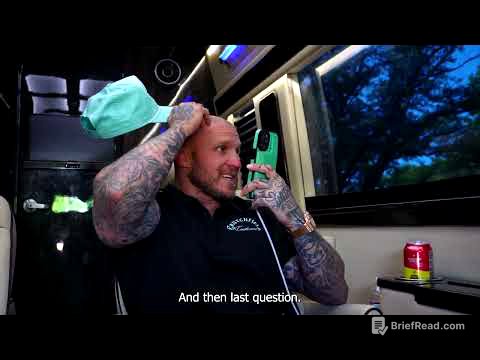TLDR;
This video summarizes David Goggins' book "Can't Hurt Me," emphasizing mental toughness, overcoming adversity, and reaching one's full potential. It outlines Goggins' life story, from a difficult childhood to becoming a Navy SEAL and ultra-endurance athlete, and presents ten challenges to help viewers transform their own lives.
- Overcoming a victim mindset and taking responsibility.
- Embracing discomfort and pushing beyond perceived limits.
- Using past struggles as fuel for future success.
- The importance of self-accountability and discipline.
Introduction to David Goggins [0:04]
David Goggins is a retired Navy SEAL, the only member of the U.S. Armed Forces to complete SEAL training, U.S. Army Ranger School, and Air Force Tactical Air Controller training. He has participated in over 60 ultra-marathons, triathlons, and ultra-triathlons, often finishing in the top five and setting new course records. Goggins also holds a Guinness World Record for completing 4,030 pull-ups in 17 hours. Today, he is a sought-after public speaker, sharing his story with Fortune 500 companies, professionals, sports teams, and students.
Overview of "Can't Hurt Me" [1:09]
The book "Can't Hurt Me" focuses on unlocking true potential by freeing the mind and building a strong foundation. It encourages readers to abandon a victim mindset and take full responsibility for their lives. The video emphasizes the importance of understanding the techniques in the book and accepting the ten challenges to strengthen the mind through repetition. The mission is not about feeling good but about becoming better and positively impacting the world, urging individuals to persevere until the work is done.
Unveiling True Potential [2:18]
Many people live at only 40% of their potential, often seeking comfort and making excuses. Goggins shares his personal experiences with a difficult childhood marked by abuse, poverty, and racism. He highlights that motivation alone is insufficient for change; one must embrace pain and suffering to transform. He recounts an experience at MIT where he challenged the notion of genetic limits to mental toughness, asserting that hard work, pain, and a strong mind can enable anyone to change completely.
The Warrior Mindset [5:28]
Drawing from the philosopher Heraclitus, Goggins emphasizes the importance of being a warrior who masters their mind and achieves greatness by facing the truth and holding themselves accountable. He encourages readers to go beyond their pain, embrace fear, and find enjoyment even in defeat to discover their full potential. Education, habits, and stories can drive change, and Goggins' experiences teach how to maximize the brain and body's capacity. Adversities like injury, divorce, depression, obesity, tragedy, or poverty can become fuel for transformation through steps that break barriers and bring glory and peace.
Challenge 1: Confronting Your Past [7:23]
The first challenge involves acknowledging and detailing past traumas, sadness, and obstacles. Goggins recounts his early life in Williamsville, Buffalo, marked by domestic violence and his father's controlling behavior at their family's skating rink, Skateland. He describes the hidden pain behind the facade of a happy family, including his father's abuse, affairs, and the family's financial struggles. He shares instances of physical abuse, threats, and the constant tension that defined his childhood.
Escaping the Nightmare [11:02]
Goggins continues to describe his attempts to find normalcy through activities like Cub Scouts, which were disrupted by his father's actions. He recounts a harrowing incident where his father threatened him with a gun, leading to a breaking point where his mother decided to leave. They escaped to her parents' home in Brazil, Indiana, seeking refuge from the abusive environment. Despite the change, the internal pain remained.
New Challenges and Stuttering [16:21]
In third grade, Goggins faced new academic challenges and a teacher, Miss D, who was unsupportive. His struggles with reading and writing led to a recommendation for special school, triggering a stutter. As the only black child in school, he felt isolated and misunderstood. The school environment became torturous, and his anxiety increased, leading to hair loss and skin problems. He was diagnosed with ADHD and prescribed Ritalin, but the real issue was toxic stress damaging his brain.
Finding a Way Out [20:00]
Goggins' mother fought against sending him to a special school, but he resorted to cheating to cope with academic difficulties. He felt increasingly distant from his studies and believed he would always fail. The challenge is to write down all past sadness, hurdles, excuses, and problems in detail without hiding anything, giving shape to the pain and accepting it as a source of future power.
Challenge 2: The Accountability Mirror [22:50]
The arrival of Wilmoth Irwin brought a new beginning, offering support and peace. However, this was shattered when Wilmoth was murdered, sending Goggins and his mother into another emotional breakdown. Despite this, they moved to Indiana, where Goggins attended Cathedral High School before returning to public school. He adopted a hip-hop persona to fit in but felt insecure. Racism became more apparent, leading to incidents of abuse and threats.
Facing Racism and Finding Purpose [26:52]
Goggins became secretive in school to avoid attention, but racism persisted, culminating in a death threat. He found solace in Malcolm X's speeches, which revealed the truth about his life. Inspired by his grandfather's Air Force service, he joined the Civil Air Patrol and was moved by a pararescue man's story of overcoming a near-fatal accident. After failing the ASVAB test, he realized he needed to change.
The Accountability Mirror Ritual [29:54]
Goggins started an accountability mirror ritual, writing goals and insecurities on post-it notes and sticking them to the mirror. This daily practice instilled discipline and motivation. He sought help from a tutor, memorizing notes and using flashcards to improve his studies. He cleared the ASVAB test and realized that his harassers were also insecure. The challenge involves using a mirror to confront insecurities and goals, writing them down, and taking small, necessary steps toward improvement.
Challenge 3: Stepping Out of Your Comfort Zone [33:07]
Goggins worked as a pest control worker, ashamed of his job and his weight of 300 pounds. He recalled his dream of becoming a pararescue man and felt like an imposter. After seeing a Navy SEAL training show, he decided to change his life and become a SEAL. He contacted recruiters and eventually met Steven Sejo, who helped him start his transformation. He had to lose weight and pass the ASVAB test.
The Transformation Begins [38:16]
Goggins started a rigorous routine, waking up early, studying, swimming, and working out. He faced depression and anxiety but used them as motivation. He listened to the Rocky soundtrack and visualized becoming a SEAL. The challenge is to identify uncomfortable tasks that are good for you and repeat them, pushing yourself little by little to challenge yourself daily and strengthen your mind.
Hell Week and Mental Warfare [42:42]
Goggins describes the brutal Hell Week, where instructors pushed recruits to their breaking points. He decided to play the game with his mind, refusing to quit. He emphasizes that Hell Week is a test of mental strength. He and his boat crew worked together, stealing instructors' schedules to gain a tactical advantage. He used his sorrow, anger, and pain to motivate his crew, showing the instructors their toughness.
Taking Souls and Controlling the Mind [46:32]
Goggins explains the concept of "taking souls," pushing oneself so far ahead that it shakes the opponent. This is a mind game to find your power. He emphasizes the importance of preparing the mind and body, identifying weaknesses, and exploiting the weaknesses of others. The challenge is to decide who your opponent is and force them to see your excellence by exceeding their standards.
Overcoming Physical Pain [52:59]
Despite severe knee pain, Goggins hid his discomfort and completed underwater training. He realized that his past hardships had strengthened his mind, forming calluses. He flipped his thinking, viewing pain as a training ground. However, his knee was fractured, and he was sent home. The challenge is to remember tough moments to gain the power to fight again, controlling your thoughts and breaking barriers.
Returning to Training [55:44]
Goggins faced claustrophobia on the train back home and contemplated giving up. He confronted his fears in the accountability mirror and decided to try again. He accepted his past and used his sorrows as fuel. He reverted to Class 235, focusing on survival. He observed how a weak foundation can break a mindset, even in elite athletes. He came out of Hell Week again with fractures in both shoulders but continued to push through the pain.
Challenge 5: Visualization [1:00:19]
Goggins completed pool tests with hands and feet tied and participated in island training. He graduated, viewing the training as a battlefield. The challenge is to visualize overcoming obstacles and achieving goals, planning for challenges, and answering the question of why you are doing it.
The San Diego One Day Race [1:02:13]
Goggins ran the San Diego One Day Race to qualify for Badwater 135, despite a lack of training. He ran for his SEAL brothers who died in Operation Red Wings, aiming to raise money for their families. He pushed through extreme pain, remembering his past victories to motivate himself. He completed 101 miles, mastering his mind and enjoying the pain.
Challenge 6: The Cookie Jar [1:08:37]
The challenge involves creating a "cookie jar" by writing down achievements and struggles to draw on during tough times. Goggins returned to work after the race and was not impressed by his performance. He was suggested to run another tough race, Hurt 100 in Hawaii. He ran the race despite injuries and understood the 40% rule, realizing that there is always more potential within us.
The Hurt 100 Race and the 40% Rule [1:11:01]
Goggins ran the Hurt 100 race in Hawaii, pushing himself to the limit and understanding the 40% rule. He completed the race and applied for Badwater. He trained strategically, visualizing every pain and weakness. The challenge is to gradually remove the governor of your mind by pushing 5-10% beyond your normal stopping point.
The Ultraman Race and a New Perspective [1:20:27]
Goggins participated in the Ultraman race in Hawaii, facing numerous challenges but finishing second. He realized the importance of strategy and backstop. Admiral Winters asked him to help recruit African Americans into the Navy. Goggins traveled extensively, giving speeches and training, managing a tight schedule. The challenge is to tighten your schedule, remove useless habits, and treat each day like a mission.
Heart Problems and a New Challenge [1:26:16]
Goggins was preparing for the Race Across America when he discovered he had a hole in his heart since childhood. He underwent surgery but faced complications. The Navy suggested retirement, but Goggins refused. The challenge is to schedule your day, focus on one task at a time, and eliminate multitasking.
Jungle Warfare and the Ranger School [1:30:13]
Goggins underwent a second surgery and returned to his old life in the jungle. He trained in jungle warfare in Malaysia and decided to attend Army Ranger School. He became First Sergeant of Bravo Company and graduated, becoming an unlisted honor man. He learned leadership qualities and inspired others.
The Importance of Leadership [1:36:12]
Goggins returned to his SEAL team and became the head of PT, but his intense training regimen was not well-received. He realized that his disappointment was his own problem and that his real duty was to inspire the team. He applied for Delta Force but was not selected. He became a Warrior instructor and used this feeling as fuel.
Challenge 9: Being Uncommon Among Uncommons [1:39:59]
The challenge is to not stop at just reaching one level but to constantly strive for more. Goggins attempted to break the world record for pull-ups to raise money for charity. He failed on the Today Show but analyzed his errors and tried again. He failed again but continued to analyze and improve.
Breaking the Pull-Up Record [1:46:54]
Goggins attempted the pull-up record again, making adjustments to his equipment and mindset. He broke the record, completing 4,031 pull-ups. He realized that the real race is with yourself, finding your limits and pushing every ability to the limit.
Challenge 10: After Action Reports [1:48:37]
The challenge is to analyze your failures, writing down what went right and what went wrong, and to create a plan for the next attempt. Goggins continued to face challenges, including a changed Badwater course and being overweight. He won the Frozen Otter Race but overtrained for Badwater and had to quit.
The Importance of Gratitude [1:52:57]
Goggins realized he had been ignoring his body and started stretching. He retired from the Navy in 2015 and became a wildland firefighter. He reconnected with his brother and understood the importance of gratitude. He emphasized that the biggest enemy is doubt and that we should accept our sorrows and make them our fuel.
The Final Message [1:56:14]
Goggins encourages readers to break their limits and to have a calloused mind. He emphasizes that there is no ending in this way of life and that growth will always continue. He is still pushing himself and setting impossible goals. He ends by asking, "What if?"









